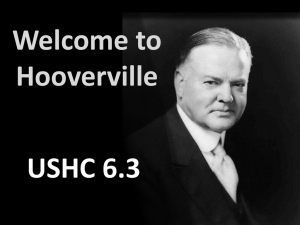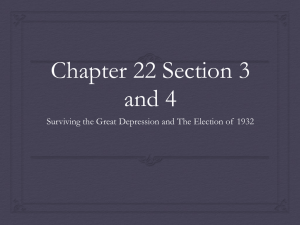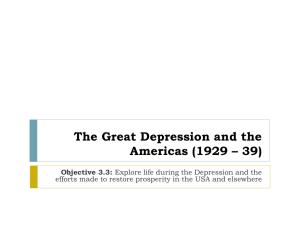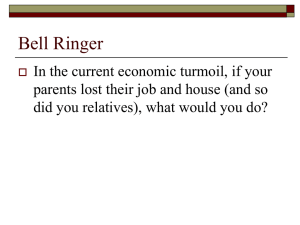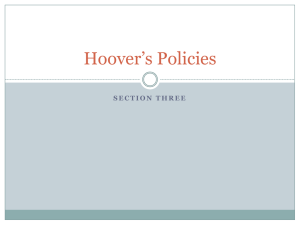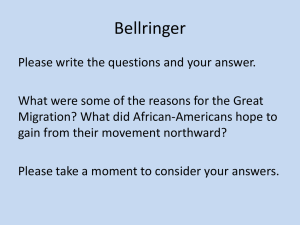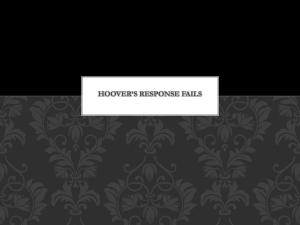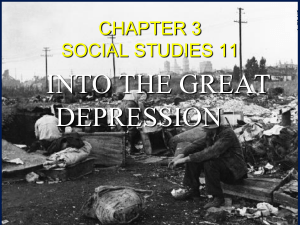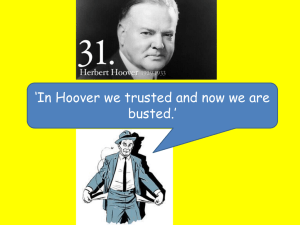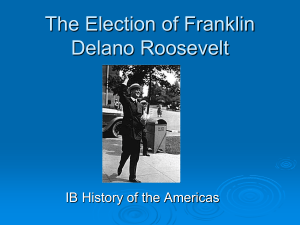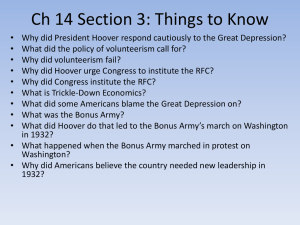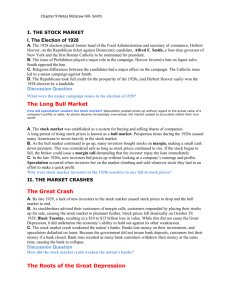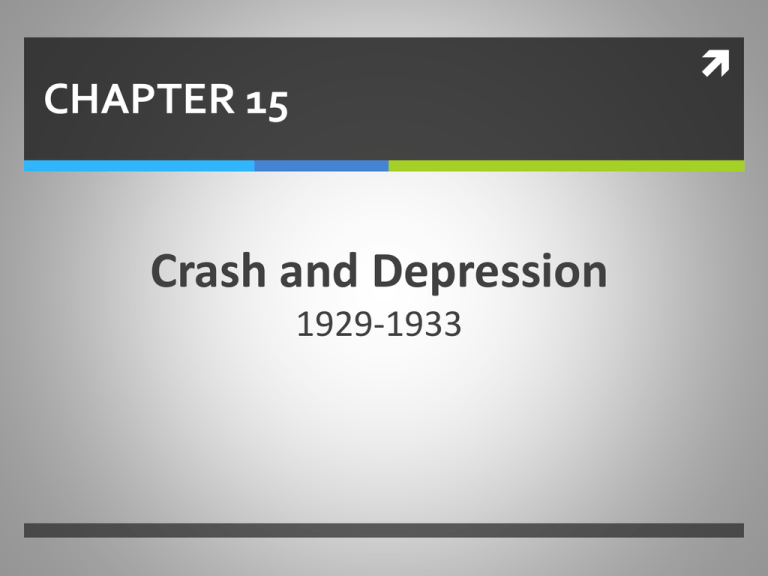
CHAPTER 15
Crash and Depression
1929-1933
CHAPTER 15: Crash and Depression
Section 1
The Stock Market Crash
Section 2
Social Effects of the Depression
Section 3
Surviving the Great Depression
Section 4
The Election of 1932
The Stock Market Crash
What events led to the stock market’s Great Crash in
1929?
Why did the Great Crash produce a ripple effect
throughout the nation’s economy?
What were the main causes of the Great Depression?
Surviving the Great Depression
In what ways did Americans pull together to
survive the Great Depression?
What signs of change did Americans begin to
notice in the early 1930s?
Americans Pull Together
Farmers Stick Together: farmers worked together to minimize
the impact of the Depression: when farmers were unable to pay
their mortgage, banks would foreclose on the property and sell
it at auction; in some farm communities, local farmers met
secretly and agreed to keep bids low during the auction
known as penny auctions, farmers would bid mere pennies on
land and machines auctioned by the banks in order to help their
struggling neighbors, and buyers would then return the farms and
machinery to the original owners
Americans Pull Together
Young People Ride the Rails: in the mid-1930s there were
roughly 250,000 teenagers living on the road, illegally
riding the rails of freight trains; some road the rails to find work
while others looked for adventure
Called “hobos,” they faced danger every day: they were
vulnerable to train-related injuries, the possibility of being
arrested by police, or the possibility of being shot at by angry
farmers
Americans Pull Together
Seeking Political Solutions: for some Americans, radical and
reform movements offered solutions to the country’s
problems
the Communist Party had about 14,000 members, mainly
intellectuals and labor organizers, by promising a fairer
distribution of wealth
Socialists called for gradual social and economic changes and did
even better
Humor: jokes and cartoons helped people through their
troubles
Signs of Change
Prohibition Is
Repealed
In February 1933, Congress passed the Twenty-first
Amendment, which repealed the eighteenth amendment
prohibiting the sale of alcohol.
The Empire
State Building
2,500 to 4,000 people worked on the construction.
The cost of construction was about $41 million.
At that time, it was the world’s tallest building and had
102 stories and 67 elevators.
The End of an
Era
Many things that symbolized the 1920s faded away.
- Organized crime gangster Al Capone was sent to
prison.
- Calvin Coolidge died.
- Babe Ruth retired.
The Election of 1932
How did President Hoover respond to the Great
Depression?
What did Roosevelt mean when he offered Americans
a “New Deal”?
Why was the election of 1932 a significant turning
point for American politics?
Hoover’s Limited Strategy
Voluntary Action Fails: Hoover believed voluntary controls by business
leaders were best way to end economic crisis, so Hoover got business
leaders to maintain wage rates
Hoover’s plan unattractive to Americans and they began to blame him
for the crisis
The Government Acts:
Agricultural Marketing Act (1929): relief for farmers by creating a
Federal Farm Board to stabilize the prices of farm crops; was a failure
losing over 150 million and sending farm prices on another downward
spiral
As hardships continued and criticism increased, Hoover took more
active approach: to create government jobs, the government spent
more on new public buildings, roads, parks, and dams
1930: Boulder Dam (Hoover Dam)
Hoover’s Limited Strategy
The Government Acts:
Hawley-Smoot tariff (1930): passed by Congress in an attempt to
protect domestic industries from foreign imports > highest import
tax in history
Tariff backfired when European countries raised their own tariffs
and international trade was brought to a sudden slowdown
Reconstruction Finance Corporation (RFC): 1932- gave government
credit to institutions, such as large industries, railroads, and
insurance companies; lent money to banks so that they could extend
loans
Home Loan Bank Act (1932): discounted mortgage rates, helping
homeowners save their homes and farmers to keep their farms
Hoover’s Limited Strategy
Hoover’s Unpopularity Grows: Hoover argued that direct
federal relief would destroy people’s self-respect and create a
large bureaucracy and insisted that state and local governments
should handle relief
His refusal to provide direct aid brought bitter public reactions
and negative publicity
In 1932, Hoover let the RFC lend the states money for
unemployment relief, but it was too little too late
Hoover’s Limited Strategy
Veterans March on Washington: In the summer of 1932,
20,000 jobless WW1 veterans and their families (known as the
Bonus Army) marched to Washington D.C., asking for
immediate payment of a pension bonus that had been
promised for 1945
House of Representatives agreed, but the Senate said no; most
of the Bonus Army went home then, but a few thousand stayed
and lived in shacks
Bonus marchers were generally peaceful, but a few violent
incidents prompted Hoover to order General Douglas MacArthur
to clear Pennsylvania Avenue
MacArthur used force to drive the marchers out of Washington >
many people were injured
Veterans March on Washington
A “New Deal” for America
FDR promised a New Deal for the American people.
He was ready to experiment with government roles in an effort to end
the Depression.
As governor of New York, Roosevelt had set up an unemployment
commission and a relief agency.
FDR’s wife, Eleanor, was an experienced social reformer. She worked for
public housing legislation, state government reform, birth control, and
better conditions for working women.
When the Roosevelts campaigned for the presidency, they brought their
ideas for political action with them.
The Election of 1932
Franklin Roosevelt
Herbert Hoover
Believed that government had a responsibility
to help people in need.
Believed that federal government should
not try to fix people’s problems.
Called for a reappraisal of values and more
controls on big business.
Argued that federal aid and government
policies to help the poor would alter the
foundation of our national life.
Helped many Americans reassess the
importance of “making it on their own”
without any help.
He argued for voluntary aid to help the
poor and argued against giving the
national government more power.
Hoover gave very few campaign
speeches and was jeered by crowds.
Much of his support came from urban
workers, coal miners, and immigrants in need
of federal relief.
Roosevelt won 57 percent of the popular vote
and almost 89 percent of the electoral vote.


